When it comes to using the CentOS operating system, having a clear understanding of the file organization is crucial for efficient navigation and management of the system. The way files and directories are structured in CentOS follows a hierarchical system, which allows for better organization and ease of access to different components of the operating system.
At the top of the hierarchy lies the root directory, often represented by the symbol "/", which serves as the starting point for all file paths in the system. From the root directory, the file system branches out into various directories, each serving a specific purpose. These directories are like containers, organizing various files and subdirectories in a logical and systematic manner.
One important directory in CentOS is the "bin" directory. It contains essential executable binary files that are required for basic command execution. Commands such as "ls" for listing files and "mkdir" for creating directories are located in the bin directory. This directory is vital for any user or administrator as it houses the fundamental system commands necessary for day-to-day operations.
Another significant directory in the CentOS file hierarchy is the "etc" directory. This directory contains system configuration files that are vital for the proper functioning of various software and services in the operating system. Configuration files for network settings, user accounts, and system-wide preferences can be found within the etc directory. Understanding and modifying these configuration files can deeply impact the overall behavior of the CentOS operating system.
The Significance of Directory Structure in CentOS Linux
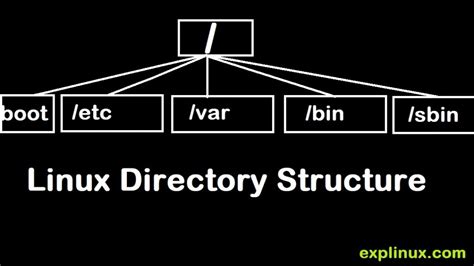
The organization of files and directories plays a crucial role in the efficient functioning of the CentOS Linux operating system. A well-designed directory hierarchy simplifies system management, enhances security, and improves overall performance.
- Understanding the File System: Exploring the layout of the directory structure is vital for navigating and managing files in CentOS Linux. It allows users to comprehend the organization of essential system files, user files, and shared resources.
- Efficient System Administration: The directory hierarchy provides a logical and systematic approach to system administration tasks. Administrators can easily locate configuration files, application data, and log files, making troubleshooting and maintenance activities more streamlined and effective.
- Enhanced Security and Access Control: A well-structured directory system enables precise access control. By assigning appropriate permissions and ownership levels to directories and files, administrators can ensure the confidentiality, integrity, and availability of system resources.
- Support for Application Development: Developers rely on the directory hierarchy for consistent and organized placement of application-related files. This allows for easier collaboration, version control, and deployment of software, fostering a more efficient development environment.
- Scalability and Compatibility: The directory structure in CentOS Linux can accommodate the growth and scalability needs of a system. It offers flexibility to add new directories or modify existing ones, making it adaptable to evolving software and hardware requirements.
In conclusion, understanding the importance of the directory structure in CentOS Linux is vital for efficient system management, enhanced security, and seamless application development. By organizing files and directories effectively, users can optimize their experience with the operating system and ensure the stability and reliability of their CentOS Linux environment.
Exploring the Root Directory in CentOS Linux
In this section, we will delve into the core directory at the foundation of the CentOS Linux operating system – the root directory. By gaining a comprehensive understanding of this fundamental directory, you will develop a firm grasp of the underlying structure and organization of the CentOS Linux file system.
The Foundation of the CentOS Linux File System
The root directory serves as the starting point for all file paths in CentOS Linux. It can be thought of as the primary hub from which all other directories and files branch out. By exploring the contents of the root directory, you will become familiar with the essential directories and files that contribute to the overall functionality and operation of the operating system.
Key Subdirectories within the Root Directory
Within the root directory, you will encounter various subdirectories that play distinct roles and house specific types of files. These subdirectories, such as /bin, /etc, /lib, and /var, are integral parts of the CentOS Linux file system architecture. By understanding the purposes and significance of these subdirectories, you will gain insight into the organization and distribution of essential system files and resources.
The Role of Configuration Files
An important aspect of the root directory is the presence of configuration files in the /etc subdirectory. These files contain settings and parameters that define the behavior of various system components and applications. Exploring these configuration files will allow you to gain control and customization options for your CentOS Linux environment.
Conclusion
By exploring the root directory in CentOS Linux, you will uncover the cornerstone of the file system and the pathway to understanding the inner workings of the operating system. Familiarizing yourself with the key subdirectories and configuration files within the root directory will provide you with a solid foundation for efficiently navigating and managing your CentOS Linux system.
Exploring the /bin Folder in CentOS: Unveiling the Core Command Line Utilities
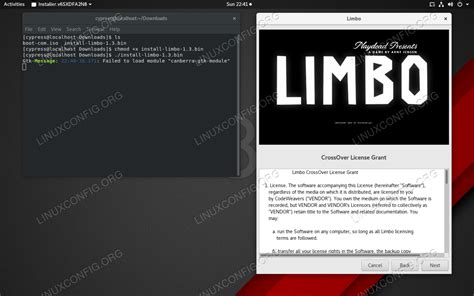
Delve into the heart of your CentOS system by unraveling the secrets of the /bin directory. Here, you will uncover a treasure trove of essential command line tools that serve as the building blocks of your Linux experience.
The Role of the /etc Directory in CentOS Linux
In the vast world of CentOS Linux, where the organization and structure of directories play a significant role, the /etc directory stands as a crucial component. This article delves into the vital role played by the /etc directory and its significance in the overall functioning of the CentOS Linux operating system.
At its core, the /etc directory serves as a centralized location for configuration files and system-wide settings. It acts as a hub that houses crucial information required by various applications, services, and utilities installed on the CentOS Linux system.
- One of the primary purposes of the /etc directory is to store important system configuration files. These files contain the settings that determine how software and hardware components interact within the CentOS Linux system. Examples of such files include passwd, group, and hosts.
- In addition to system configuration files, the /etc directory also contains files for managing network-related settings. These files include hostname, network, and resolv.conf. By storing these files in a centralized location, CentOS Linux ensures easy access and allows administrators to make necessary changes efficiently.
- Furthermore, the /etc directory stores scripts and files that play a crucial role in the booting and shutting down processes of the CentOS Linux system. This includes files like rc.sysinit and rc.local. The presence of these files in the /etc directory ensures the smooth functioning of the system's startup and shutdown procedures.
In conclusion, the /etc directory acts as a cornerstone in the CentOS Linux system, providing a centralized location for crucial configuration files, network settings, and boot-related scripts. Its organization and structure contribute to the overall stability and efficient functioning of the operating system.
Managing System Files with the /lib Directory in CentOS Linux
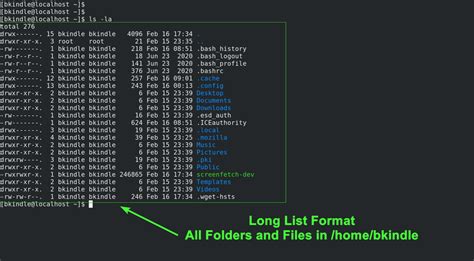
In this section, we will explore the important role played by the /lib directory in the CentOS Linux operating system. We will delve into its functions and how it facilitates the management of crucial system files.
- Introduction to the /lib Directory
- Understanding the Purpose of the /lib Directory
- Organizing System Libraries in the /lib Directory
- Key System Files Found in the /lib Directory
- Dependency Management within the /lib Directory
- Securing System Files in the /lib Directory
This section will provide a comprehensive overview of the /lib directory in CentOS Linux, shedding light on its significance for system file management. By understanding the functionality and structure of this directory, users can effectively navigate and utilize important system files in a secure and efficient manner.
Navigating the /usr Directory in CentOS Linux
In this section, we will explore the structure and contents of the /usr directory in CentOS Linux, a widely used operating system. The /usr directory is a significant component of the file system, containing various files and directories that are essential for system functionality.
When you navigate through the /usr directory, you will encounter a diverse range of directories and files, each serving a specific purpose. This section aims to provide a comprehensive understanding of the different elements within the /usr directory and how they contribute to the overall functionality of the CentOS Linux system.
| Directory | Description |
| /usr/bin | The /usr/bin directory contains binary executables that are accessible to all users of the system. These executables are commonly used for various system tasks and command-line operations. |
| /usr/lib | The /usr/lib directory houses libraries and shared resources that are required by the system and various applications. These libraries are crucial for the proper functioning of software installed on the CentOS Linux system. |
| /usr/share | The /usr/share directory contains shared data used by applications installed on the CentOS Linux system. This includes documentation, localization files, and other resources that enhance the user experience. |
| /usr/include | The /usr/include directory houses header files that are essential for software development and compiling programs. These files provide necessary information and definitions for properly interacting with libraries and external dependencies. |
| /usr/local | The /usr/local directory is commonly used for the installation of software and libraries that are not provided by the CentOS Linux distribution itself. It helps separate user-installed applications from system-provided ones. |
Understanding the structure and contents of the /usr directory is crucial for efficiently navigating and utilizing the CentOS Linux system. By familiarizing yourself with these directories, you can effectively manage and interact with the various components that make up the file system, ultimately enhancing your overall experience and productivity on CentOS Linux.
The Importance of the /var Directory in CentOS Linux
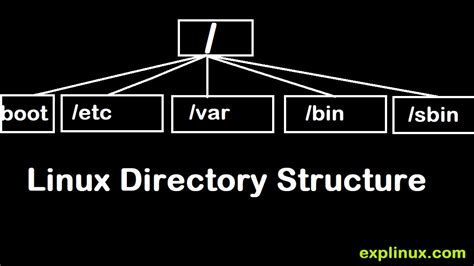
In the CentOS Linux operating system, the /var directory plays a crucial role in ensuring the proper functionality and management of various system components. Serving as a storage location for variable data, the /var directory accommodates files and directories that are subject to frequent changes during the system's operation.
Within the /var directory, you can find a diverse range of data, including log files, mail spool directories, temporary files, databases, and other dynamic content. This directory is designed to cater to the needs of ongoing processes and applications that require a location to store their variable data.
One significant aspect of the /var directory is its ability to facilitate system monitoring and troubleshooting. By storing log files in this directory, system administrators can easily access and analyze valuable data that can help diagnose and rectify issues. These logs capture crucial information related to system events, user activities, and various services, enabling a comprehensive understanding of the system's overall health.
An additional advantage of the /var directory is that it enables seamless data sharing between different applications and users. As a common storage location for diverse types of variable data, it allows multiple processes to access and modify the information they require. This fosters efficient collaboration among applications and streamlines data handling throughout the system.
Furthermore, the /var directory plays an integral role in maintaining the system's stability and resilience. By providing a specific location for the storage of temporary files, it prevents cluttering in essential system areas and ensures proper resource utilization. Regularly cleaning and managing the contents of the /var directory is crucial to optimize system performance and prevent potential issues caused by overloaded storage.
In summary, the /var directory serves as a dynamic storage hub within the CentOS Linux system, accommodating variable data and supporting the smooth operation of various processes and applications. Its significance lies in providing a centralized location for critical files, facilitating system monitoring and troubleshooting, enabling data sharing between applications, and contributing to the overall stability and reliability of the system.
Exploring User Directories in CentOS Linux
Delving into the user directories in CentOS Linux unveils a rich ecosystem tailored to cater to each user's needs and preferences. These personal directories harbor a multitude of files, configurations, and settings that contribute to the unique user experience within the Linux environment.
- Understanding the Home Directory
- Unveiling the User Profile and Configuration Files
- Navigating the Public Directory
- Exploring Shared Directories
- Discovering Hidden Directories
- Managing Permissions and Access Control
At the core lies the home directory, serving as the central hub of the user's digital ecosystem. Here, personal files, documents, and folders find their place, enabling seamless organization and easy access. The user profile and configuration files play a crucial role in customizing the Linux experience, allowing users to fine-tune their desktop environment, application settings, and command-line preferences.
The public directory opens a window of collaboration, providing a space where users can share files, documents, and resources with other individuals or groups within the system. Alongside, shared directories foster teamwork and seamless file exchange, facilitating collective projects and enhancing productivity.
Delving deeper into the directory structure, hidden directories unveil a cryptic world, concealing system settings, cached data, and temporary files. Understanding and managing these hidden directories can help users keep their system lean and optimize its performance.
Lastly, ensuring proper permissions and access control within user directories guarantees the privacy and security of personal files and data. By assigning appropriate permissions, users can restrict or grant access to their directories, ensuring that only authorized individuals or processes can view or modify their contents.
By unraveling the subtleties of user directories, CentOS Linux empowers users to harness the full potential of their digital workspace, personalizing it to suit their unique needs and preferences. Whether navigating the depths of hidden directories or collaborating in shared spaces, users can fully immerse themselves in the CentOS Linux experience.
Working with Temporary Files in the /tmp Directory in CentOS Linux
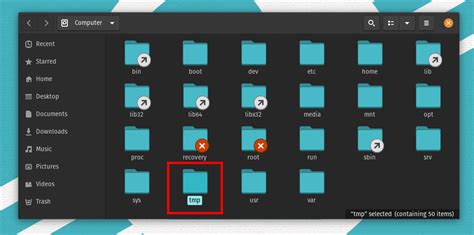
In this section, we will explore the concept of temporary files in CentOS Linux and how to effectively work with them within the /tmp directory. Temporary files play a crucial role in various tasks, providing a space for storing data that is only needed for a short duration. By understanding how to manage temporary files in CentOS Linux, you can ensure efficient usage of system resources and maintain a clean and organized file system.
Temporary files serve a range of purposes, from storing intermediate results during program execution to providing a temporary workspace for various processes. The /tmp directory in CentOS Linux is designated specifically for the storage of such temporary files. It is important to handle these files correctly to avoid cluttering the file system and to prevent potential security vulnerabilities.
- Creating temporary files: We will explore how to create temporary files using different methods available in CentOS Linux. This includes using the mktemp command and various programming languages such as Bash, Python, and Perl.
- Managing temporary files: Once temporary files are created, it is important to properly manage them. We will discuss techniques for tracking, organizing, and cleaning up temporary files to ensure optimal system performance.
- Security considerations: Temporary files can pose security risks if not handled properly. We will cover best practices for securing temporary files, including setting appropriate permissions and implementing file deletion strategies.
- Optimizing temporary file usage: Efficient usage of temporary files can significantly enhance system performance. We will explore techniques for minimizing temporary file usage and optimizing file operations to boost overall system efficiency.
By gaining a comprehensive understanding of working with temporary files in the /tmp directory in CentOS Linux, you will be equipped with the necessary knowledge and skills to effectively manage and utilize temporary files in your Linux environment.
Customizing the File Organization in CentOS OS
In this section, we will explore how to personalize and tailor the structure of files and directories in the CentOS operating system. By customizing the file organization, users can optimize their workflow, enhance system performance, and easily find and access important files and directories.
- Efficiently categorize and group files: Users can create custom directories and subdirectories to organize files based on their specific needs. This allows for a logical and systematic arrangement of files, making it easier to locate and manage them.
- Set access permissions: By customizing the directory hierarchy, users can assign different access levels to specific directories or files. This ensures that only authorized individuals have the ability to access and modify sensitive information, enhancing security within the system.
- Create symbolic links: Customizing the directory hierarchy also involves creating symbolic links, which are shortcuts or references to other directories or files. Symbolic links can simplify navigation and provide quicker access to frequently used directories or files.
- Customize directory names: Users have the freedom to rename directories according to their preferences or organizational requirements. Renaming directories can help improve the clarity and understandability of the file system structure.
- Optimize disk space allocation: By customizing the directory hierarchy, users can carefully distribute files across different partitions or storage devices. This allows for efficient utilization of disk space and can contribute to improved system performance.
Customizing the directory hierarchy in CentOS Linux offers users the flexibility to adapt the file organization to their specific workflow and preferences. By implementing these customizations, users can enhance efficiency, security, and overall usability of the CentOS operating system.
The Linux Filesystem Explained | How Each Directory is Used
The Linux Filesystem Explained | How Each Directory is Used by Akamai Developer 215,284 views 1 year ago 14 minutes, 8 seconds
Linux Directories Explained - including /etc /home /var /proc /usr
Linux Directories Explained - including /etc /home /var /proc /usr by Gary Explains 37,943 views 4 years ago 13 minutes, 39 seconds
FAQ
What is the purpose of the directory hierarchy in CentOS Linux?
The directory hierarchy in CentOS Linux is designed to organize and structure the files and directories in the operating system. It helps in maintaining order, separating system files from user files, and providing a standardized layout for ease of use and administration.
Can I modify the directory hierarchy in CentOS Linux?
Modifying the directory hierarchy in CentOS Linux is generally not recommended as it can disrupt the functioning of the operating system and cause issues with package management. It is best to adhere to the standard directory structure unless you have a specific and valid reason to make modifications.




